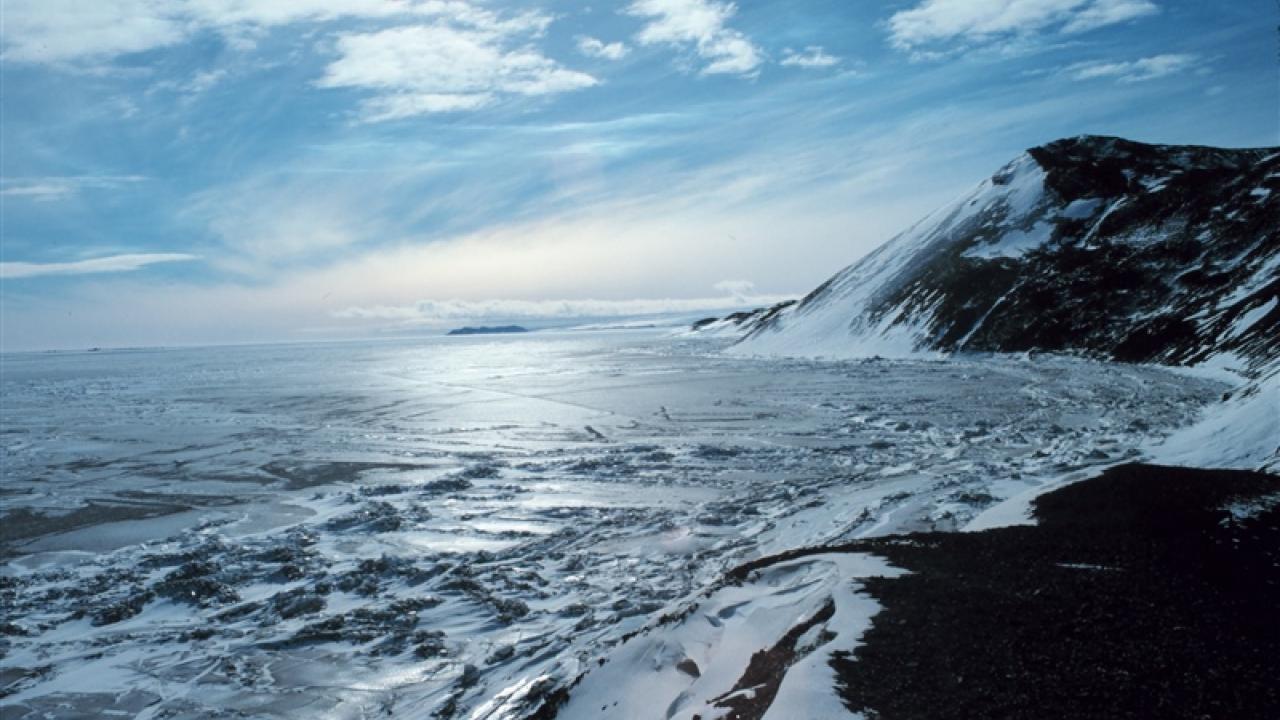
Exploring the Ice Surface with Graduate Student Maggie Berrens
Approximately 10% of the Earth’s surface is covered in ice. Creeping glaciers, swaying sea ice and continental sheets make up this small percentage, but that amount is continuously shrinking due to climate change.
As ice melts, its surface acts as a catalyst for environmental reactions. On the ground, these reactions can lead to the release of trace gases, like nitrogen oxides and other harmful pollutants, trapped in snowpacks. High in the sky, melting polar stratospheric clouds—which are composed of ice crystals—can lead to the production of ozone-depleting substances.
In the lab of Professor of Chemistry Davide Donadio, physical chemistry graduate student Maggie Berrens investigates the fundamental properties of the ice surface to better understand the molecular interplay and energetics of these reactions.
But doing such work is difficult to achieve experimentally.
“It’s challenging to take, for example, light absorption spectroscopy of molecules at the ice surface at concentrations comparable to those seen in the environment,” said Berrens. “So, we’re using computational tools to model that spectroscopy to see if we can understand the molecular picture of these interactions that way.”
From the melting point of water down to about minus 70 degrees Celsius, the crystalline structure of the surface of ice starts to reorient, creating a disordered, pre-melted layer called the quasi-liquid layer. Through molecular dynamics simulations, Berrens and her lab colleagues can gain a clearer view of these temperature-influenced molecular interactions that are often unobservable to experimentalists. While the work is foundational, its applications are potentially wide-reaching.
“The hope is that we can use our work from the molecular perspective to give climate scientists parameters that can be useful for large-scale climate models,” Berrens said.
Berrens was also recently selected as one of the 20 UC President’s Lindau Nobel Laureate Meetings Fellows for the 73rd Lindau Nobel Laureate Meetings in Physics taking place from June 30-July 5, 2024
Frosty introductions

Berrens’ introduction to studying ice occurred during her undergrad years at University of Puget Sound in Tacoma, Washington. Double majoring in chemistry and mathematics, she found herself more intrigued by the theoretical side of chemistry. During her sophomore year, she began working with Steven Neshyba, a professor whose research focuses on modeling ice in climate systems.
In addition to climate modeling, Berrens used ice as a lens to investigate the RNA world hypothesis, which posits that life on Earth started with self-replicating ribonucleic acid (RNA) that eventually evolved into the first cellular life.
“The idea was that way back when life started, it was really cold,” Berrens said. “There was a lot of ice present, so we wanted to run molecular dynamics simulations to see if RNA strands were stable on the ice surface.”
The work led to a paper co-authored by Berrens that was published in The Journal of Physical Chemistry C. In the paper, the researchers showed through molecular dynamics simulations that at minus 20 degrees Celsius, the ice surface could act as a substrate conducive to RNA proliferation.
“That project was my first introduction to molecular modeling, as well as the ice surface’s ability to act as a substrate,” Berrens said.
Thanks to a collaborator on that paper, Berrens was introduced to Donadio, whose research convinced her to enroll at UC Davis for her graduate studies.
Problem-solving at the surface
Currently in her fourth year of graduate studies, Berrens has expanded her research concerning the surface of ice, but it’s all driven by an altruistic mindset.
“I really do have a passion to help mitigate the effects of climate change and although sometimes it’s hard to see that at the foundational level I’m doing this work at, my goal is to make meaningful contributions,” she said. “I see computational chemistry as a way to do that.”
In a paper published in ACS Earth and Space Chemistry, Berrens, Donadio and colleagues calculated the light absorption spectra of nitrate, a significant contaminant in polar snow. When struck by sunlight, the ice could act as a catalyst to produce nitrogen oxide and nitrous acid.
“The molar absorption coefficient from the light absorption spectra is a parameter that can help calculate the rates of reactions, and that’s something experimentalists can use to understand how well nitrate absorbs light at the ice surface, which influences the production of nitrogen oxides into the atmosphere,” Berrens said.
Berrens’ research is part of an ongoing conversation between theorists and experimentalists who all share a goal: to make climate modeling as accurate as possible for better decision-making.
“Computer simulations, for example, molecular dynamics simulations, offer a way to understand that molecular picture that leads to these experimental measures,” Berrens said.
